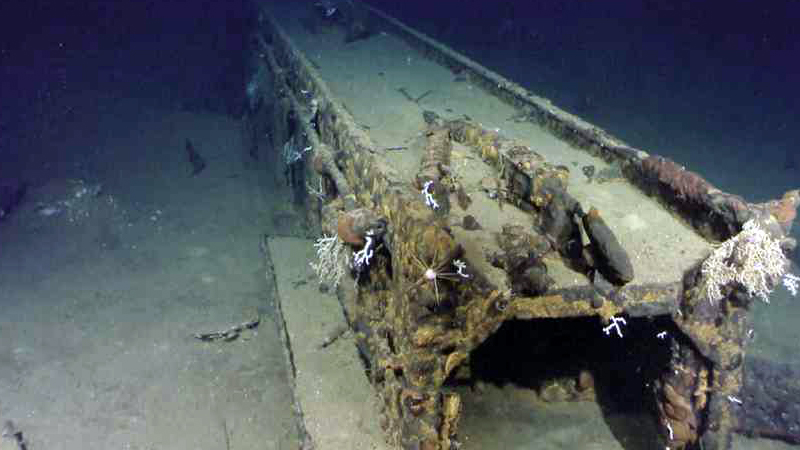
RELIC OF MIGHTY BATTLESHIP This photo taken on March 2 shows a metal beam that looks like a catapult used to launch float planes from the World War II battleship Musashi after it was found at the bottom of Sibuyan Sea by the research team of Microsoft cofounder Paul Allen. AFP/PAULALLEN.COM
Musashi, one of Japan’s biggest and most famous battleships, has been found on the seabed of Sibuyan Sea in the Philippines, some 70 years after American forces sank it during World War II.
Microsoft cofounder Paul Allen announced on Wednesday on Twitter that he had found the battleship.
Manolo Quezon, communications undersecretary of President Benigno Aquino III, said the Musashi wreck would be a “major” historical find if verified.
“This would be like finding the Titanic, because of the status of the ship and the interest in the ship,” Quezon said.
Excited historians hailed Allen for his high-tech mission that apparently succeeded after so many failed search attempts by others.
The American billionaire posted photos and a video online of parts of what he said was the battleship Musashi, found by his MY Octopus exploration vessel 1 kilometer deep on the floor of the Sibuyan Sea.
“World War II battleship Musashi sank 1944 is found,” Allen announced in a Twitter post that has been retweeted close to 19,000 times.
Eight-year search
The discovery was the end of an eight-year search for the Musashi, backed by historical data from four countries and using “advanced technology” that surveyed the seabed, Allen said in a statement on his website.
“I am honored to play a part in finding this key vessel in naval history and honoring the memory of the incredible bravery of the men who served aboard her,” he said.
Undersea footage on Allen’s website showed what were described as a valve, a catapult for planes, a gun turret and a starboard anchor.
Japanese empire seal
The footage also showed the space on the bow for the Japanese empire’s Chrysanthemum seal.
This is a unique feature of the three biggest warships that Japan built during World War II, according to Kazushige Todaka, director of the Kure Maritime Museum in Japan.
“I’m almost certain that what was discovered is the battleship Musashi,” he said, adding the find had huge historical importance.
“There have been so many efforts over the years to locate Musashi, but they all failed. I feel like the warship might have been destined to show itself this year, the 70th anniversary of the end of World War II,” Todaka said.
“With the memory of war slipping further and further from people’s minds, I hope this discovery will help make the public think about history,” he added.
The Musashi was one of a trio of vessels built by Japan during the war that, at 263 meters (863 feet) each, were its biggest battleships ever.
Largest naval battle
American warplanes sank the Musashi on Oct. 24, 1944, at the height of the Battle of Leyte Gulf, regarded as the largest naval encounter of the war in which US and Australian forces defeated the Japanese.
Dozens of Japanese warships that were sunk during World War II have since been found in the Philippines, with some of them now popular dive locations.
The Sibuyan Sea where the Musashi was found is home to busy shipping lanes in the Visayas.
51st richest
The Seattle-born Allen, 62, who founded Microsoft with Bill Gates in 1975, is the world’s 51st richest person with a net worth of $17.5 billion, according to Forbes Magazine.
He is also a famous philanthropist and businessman with a focus on innovation.
Allen is working on a project called Stratolaunch, which aims to put “cost-effective” cargo and manned missions into space.
He launched SpaceShipOne, the first privately built spacecraft, into sub-orbital space in 2004.
In Allen’s statement on his website, he said he had been driven to pursue the Musashi for many reasons.
“Since my youth, I have been fascinated with World War II history, inspired by my father’s service in the US Army,” he said.
“The Musashi is truly an engineering marvel and, as an engineer at heart, I have a deep appreciation for the technology and effort that went into its construction,” he said.
Asked about the discovery of the battleship, Armed Forces of the Philippines Chief of Staff Gen. Gregorio Pio Catapang Jr. said: “It’s a great discovery… hope it can be repaired to its original status.”
What Went Before: Biggest WW II naval battle
On October 23-25, 1944, Allied forces and the Japanese Navy engaged in the biggest naval encounter in World War II—the Battle of Leyte Gulf.
It was a decisive air and sea battle that ended with the crippling of the Japanese fleet and reinforced Allies’ control of the Pacific. The battle spanned 160,000 square kilometers of sea and involved some 700 ships.
The Battle of Leyte Gulf was composed of four separate engagements:
Battle of Cape Engaño
Battle of Sibuyan Sea, which witnessed the massive US 3rd Fleet air assault that saw the sinking of the Japanese super battleship Musashi.
Battle of Samar
Battle of Surigao Strait
All but 800 of the 80,000 Japanese died.
From Leyte, the Allied forces went on to invade Luzon and liberate Manila in February 1945. The United States granted the Philippines independence the following year.
Sources: Inquirer Archives, malacanang.gov.ph, “Kasaysayan: The Story of the Filipino People”
RELATED STORIES
Microsoft co-founder unveils space travel plans